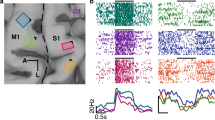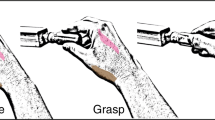Abstract
THE history of electrical stimulation of the human brain incidental to its use for therapeutic purposes extends back almost a century1. The recent exploration of the discovery that stimulation of the brain can elicit verbal descriptions of sensations was ushered in by Foerster2 and also by the extensive investigations of Penfield and his colleagues3, who were primarily limited to the cortex by the limited techniques of the day. The advent of human stereotaxic surgery4, especially for dystonias and dyskinesias such as Parkinson's disease—which can be ameliorated by lesions placed in the thalamus or basal ganglia5—has extended the possibility of obtaining reports of sensory phenomena as a result of stimulation deep within the brain. In the conscious patient this stimulation is a necessary part of the therapeutic surgical procedure. It provides information on the locus of the probe tip which must ultimately be placed in the site of the future therapeutic lesion. If the tip happens to be slightly off course in the internal capsule, the response to stimulation can prevent the disastrous error of severing this tract and resulting hemiplegia.
This is a preview of subscription content, access via your institution
Access options
Subscribe to this journal
Receive 51 print issues and online access
$199.00 per year
only $3.90 per issue
Buy this article
- Purchase on Springer Link
- Instant access to full article PDF
Prices may be subject to local taxes which are calculated during checkout
Similar content being viewed by others
References
Bartholow, R., Amer. J. Med. Sci., N. S., 67, 305 (1874). Ransom, W., Brain, 15, 437 (1892). Cushing, H., Brain, 32, 44 (1909).
Foerster, O., Brain, 59, 135 (1936), in Bumke u. Foersters Handb. Neurol., 6, 1, 358 (1936).
Penfield, W., Arch. Neurol. and Psychiat., 40, 417 (1938); Penfield, W., and Rasmussen, T., The Cerebral Cortex of Man (Macmillan and Co., New York, 1950).
Spiegel, E. A., and Wycis, H. T., Stereoencephalotomy, Part I (Grune and Stratton, New York, 1952).
Shaltenbrand, G., and Bailey, P., Introduction to Stereotaxis of the Human Brain (Georg Thieme Verlag, Stuttgart, 1959).
Dierssen, G., and Sanchez Moreno, Y., Rev. Clin. Espan., 91, 712 (1963).
Hassler, R., Deut. Zeitsch. Nervenheilk., 183, 148 (1961).
Marg, E., Nature, 202, 601 (1964).
Marg, E., and Dierssen, G., Confin. Neurol., 26, 57 (1965).
Libet, B., Alberts, W. W., Wright, jun., E. W., Delattre, L. D., Levin, G., and Feinstein, B., J. Neurophysiol., 27, 546 (1964).
Libet, B., Alberts, W. W., Wright, E. W., Levin, G., and Feinstein, B., Fed. Proc., 18/1, 363 (1959).
Powell, T. P. S., and Mountcastle, V. B., Bull. Johns Hopkins Hosp., 105, 133 (1959).
Hensel, H., and Boman, K. K. A., J. Neurophysiol., 23, 564 (1960).
Author information
Authors and Affiliations
Rights and permissions
About this article
Cite this article
MARG, E., DIERSSEN, G. Somatosensory Reports from Electrical Stimulation of the Brain during Therapeutic Surgery. Nature 212, 188–189 (1966). https://doi.org/10.1038/212188a0
Issue Date:
DOI: https://doi.org/10.1038/212188a0
Comments
By submitting a comment you agree to abide by our Terms and Community Guidelines. If you find something abusive or that does not comply with our terms or guidelines please flag it as inappropriate.



